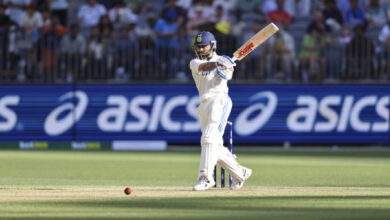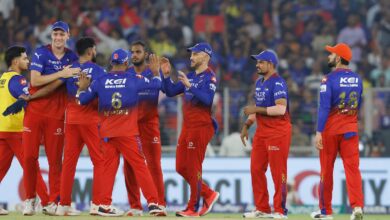With rule changes, a timeless game is speeding up

Tyler Kepner
The commissioner of Major League Baseball is always in demand, which makes it hard, these days, to actually watch a game.
For years, this was not a problem: Rob Manfred knew the natural breaks in the action — those tedious, drawn-out, “just throw the ball already!” pauses — and could adjust his conversations accordingly. Now, after a sweeping set of rule changes, his personal clock is off.
“Most of the time, I’m in a suite and I’ve got somebody talking at me about something,” Manfred said late in spring training. “Prior to the change, the pace was such that you never really lost track of the game. But the first couple of games, I’m like, ‘Can you please let me watch?’ Because you miss stuff.”
MLB’s regular season opens Thursday, and Manfred, who is starting his ninth season as commissioner, may finally get the faster-paced product he has long considered essential to the future of the sport.
“This is the game we all want to see — get the ball, pitch the ball, keep the defense on their toes,” actor Bryan Cranston says in a new MLB commercial splicing current stars with the speed-and-defense icons Rickey Henderson and Ozzie Smith. “So get that shift outta here. Free up the players to put on a show!”
A pitch clock with 15 seconds left during a spring training game between the San Diego Padres and Seattle Mariners in Peoria, Ariz., Feb. 24, 2023. With its three major rule changes this season, Major League Baseball is hoping that games will be crisper, packed with more hits, more stolen bases and more chances for players to use their athleticism, especially on defense. (Rebecca Noble/The New York Times)
A slogan flashes at the end of the ad: “Three New Rules. More Great Action.”
The big changes, which come with the nuance typical of a complicated game, are the pitch clock, a ban on the infield shift and limits on pickoff throws. A result, the league hopes, will be crisper games packed with more hits, more stolen bases and more chances for players to use their athleticism, especially on defense.
“I think fans are going to get today’s athletes, which are the best that have ever played the game, playing a game with the pace and rhythm that exed in the 1970s and ’80s, which to me is going to produce a form of the sport that no one has ever seen before,” said Morgan Sword, MLB’s executive vice president for baseball operations. “I’m really excited about it.”
Baseball is hardly in crisis; the just-completed World Baseball Classic was a rousing success, and MLB produced record revenues of nearly $11 billion in 2022. No other sport comes close to baseball’s volume of events — 81 home dates for each of 30 clubs, with an industry average of 26,566 fans per game, far more than the capacity of any NBA or NHL arena, despite having twice as many games.
Yet discounting the pandemic-influenced seasons of 2020 and 2021, attendance has fallen steadily since 2015, and last year’s average was the lowest since 1996, which had come in the wake of the 1994 strike. The sixth game of the last World Series, between Philadelphia and Houston, attracted 12.5 million viewers, the fewest ever for a decisive game in prime time.
Rule changes alone will not fix everything, and much of baseball’s quirky charm — the pitch–pitch rhythms, the absence of timed quarters or periods — will always remain. But it cannot hurt to have more stuff going on and less waiting around.
“Going up there when you’re hitting, you’ve just got to get up there and go,” said Manny Machado, the star third baseman for the San Diego Padres, who added that the adjustments would be worth it. “It’s going to be cool to see more offense, more first-to-third, more runs are probably going to be scored. But then you’re also going to see some pretty good defense.”
Pitchers have 15 seconds to start their delivery with the bases empty, and 20 seconds with a runner on base. Batters must be looking at the pitcher with eight seconds left on the clock; Machado failed to do this in the first exhibition game of spring training and was called for an automatic strike.
Yet that game, against the Seattle Mariners, was completed in 2 hours, 29 minutes, and the average time of spring training games, through Wednesday, was 2:35 — 26 minutes faster than last spring. Stolen base attempts were up to 3.1 per 100 plate appearances, from 2.1, and so was the success rate, which was 77.2% compared with last year’s 71.3%.
Before, pitchers had unlimited opportunities to pick runners off. Now, they can disengage from the rubber only twice per plate appearance; a third pickoff try, if unsuccessful, would result in a balk. And with bigger bases (18 inches square, from 15), the dance between first and second (and between second and third) is 4-1/2 inches shorter than before.
“Putting aside pace of game — which obviously is going to be huge — I initially thought the shift would have the biggest impact because it’s going to lead to less efficient positioning of the defenders and therefore more balls getting through for hits,” Rick Hahn, the Chicago White Sox’ general manager, said about halfway through the exhibition schedule.
“But I’m starting to think it’s the bigger bases. We aren’t really known as a running team, and I think we’re like 13 for 16 this spring. So teams that aren’t necessarily viewed as having that as a big part of their arsenal, it’s going to be available to them on offense.”
In many ways, baseball is trying to reverse engineer the on-field impact of its information revolution. While data analysis has promoted more exciting plays in football (more passing, less punting) and basketball (more 3-pointers, fewer midrange jumpers), in baseball it has slowed the game down.
The analytics era had many hallmarks. Stolen bases were rarely seen to be worth the risk, even for the fastest players. Infielders were positioned in the most likely places that batters would hit the ball, costing left-handed hitters, especially, countless hits. And if a batter or pitcher needed a few extra seconds to gather his thoughts or recover from a high-stress fastball, he could do so as often as he liked. Anything to optimize performance.
The impact was staggering. 2021, stolen bases had declined to 0.46 per game, a 50-year low. The leaguewide batting average fell to .243 last season, the lowest it had been since 1968. And the average time of a game stretched to 3 hours, 11 minutes in 2021, the longest it had ever been.
“A lot of people think our job, as an industry, is to win games,” Kansas City Royals infielder Matt Duffy, a seven-year veteran, said. “No. Our job is to entertain first. If the product as a whole is not entertaining, people aren’t going to come. When a ground ball is smoked at 110 miles an hour, everybody goes, ‘Oooh!’ as it goes through the infield — and then there’s a guy standing right there that they didn’t see, and it’s just another out. That’s not entertaining.
“It’s like, sorry, pitchers, but fans want to see base runners, they want to see first-to-third, they want to see triples, they want to see home runs. They don’t want to see strikeouts and nobody on base and 350 pitches thrown in a game.”
Teams must now keep two infielders on either side of second base, and infielders must keep both feet on the dirt as the pitch is thrown. Players could turn more grounders into outs with the shift in place, but few embraced the concept of playing out of position, which kept them from using their instincts and showing off their range.
“I hated when I used to have to move all the way to right field and then get a ground ball and throw the ball to first base like you’re throwing it to home plate,” said the White Sox’ Elvis Andrus, a 14-year veteran. “So I’m very comfortable just staying at second and I can concentrate on each play at second base. I think it’s going to be good for the game because now you have to play your position. You cannot cheat the system anymore. And I love to do my own homework and study hitters and their swings.”
Andrus was born in 1988, when the majors’ leading hitter (Boston’s Wade Boggs) batted .366 and the leading speedster (Henderson, then with the New York Yankees) swiped 93 bases. Last season, the overall batting leader, the New York Mets’ Jeff McNeil, hit .326. The major league leader in stolen bases, Miami’s Jon Berti, had 41. Expect both figures to rise.
“The thing that doesn’t get talked about enough is the aggregate hours that players are going to be on their feet,” said Mike Hazen, the general manager of the Arizona Diamondbacks. “It’s far fewer hours, and that will improve — I hope — our injury situation and keep our better players on the field longer.”
There will be tweaks along the way; no one would be surprised if the league announces, late in the season, that the pitch clock rules will be relaxed in the ninth inning of postseason games. But the expectation is that players are skilled enough to quickly adapt, resurrecting a style of play that older fans remember and younger fans embrace.
“We think about how we first saw the game, where the players were positioned, how fast or slow they were, and this will be the new normal for a whole generation of kids and fans,” Detroit Tigers manager A.J. Hinch said. “They will think of clocks and the speed of the game, if this enhances it — and hopefully they can get to a few more games if it’s not past their bedtime anymore.”
This article originally appeared in The New York Times.







